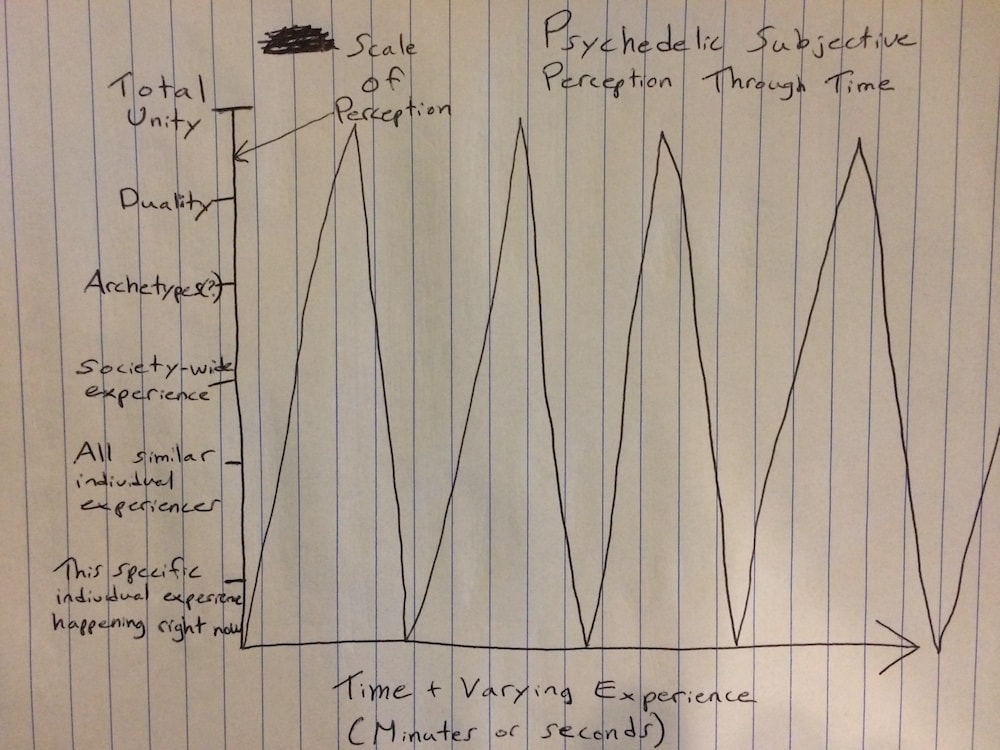The more psychedelics I take the more I have the desire to “bring something back” – a little for myself but mostly in order to be better able to convince more people to take psychedelics.
The more one can parse out the details of the experience, I think, the more able one is to explain the potential benefits to others. This is especially true when engaging with rationally minded, thoughtful people – those who, it seems to me, are especially likely to get something valuable from the experience.
We can talk about “mystical experience” (see #3 in this post) as it has been the subject of quite a bit of exploration and scholarship. We can discuss eternal bliss and unity with the divine and profundity and meaning and *the ineffable* – but that’s not what I want to explore here.
Rather this is an attempt to describe a certain aspect of the psychedelic experience that is, I think, at least in part responsible for the relationship between psychedelics and creativity. These ideas are rough and inconclusive but, depending on the reader, can still be interesting or useful.
What I am referring to is the sense of one’s perspective sliding along a scale of magnitude at a very rapid pace. During a psychedelic experience one’s perception seems to fluidly expand out to the macro and contract in to the micro within seconds.
I tried to sketch this on the graph below. The Y axis is one’s perception of their experience at a particular moment, where higher on the scale indicates greater magnitude and lower indicates smaller minutiae. Higher also coincides with greater unity and interconnectedness while lower coincides with increased separation and individuation. The X axis is the passage of time and one’s changing experience through that time.

The levels on the scale of perception are, at least based on my own experiences, from high to low:
1. Total unity and interconnectedness
2. Duality/polarity (Also known as the paradox of opposites)
3. Something like Jungian Archetypes (human species-wide universal experience)
(Level 3 and 4 likely intermediated by personal bias suppression)
4. Society-specific collective experience – the lens or perspective of one’s particular society/culture
5. All individual experiences of this type
6. This specific individual experience right now
As you are having any particular momentary experience on a psychedelic, your perception slides fluidly up and down this scale.
For example: I’m tripping and I decide to eat some melon. I take the melon out of the fridge, place it on a cutting board and begin to cut it with a kitchen knife.
At the first level, this is one particular instance of me cutting this particular melon. The experience is as individuated as possible.
I start slicing the melon thinly, length-ways. My friend points out that it would be better to quarter the melon. Of course, I think, that makes much more sense. Quartering is how people generally cut melons. It’s also how I usually cut them, when I’m not tripping. That is level two and partly three.
Then I realize (or remember, which are subjectively much more similar on psychedelics) that one generally quarters melons because it is a superior way to cut them. Me quartering the melon is an example of a human using a pre-existing best practice to carry out a task.
It strikes me that my entire life is like this to a large degree, as is everyone else’s. The enormous extent to which pre-existing knowledge informs our behaviour becomes apparent. Cutting the melon is now a microcosm of the way my own society as well as the human species in general progress through time by conscious or unconscious transfer of knowledge.
This is level three and getting in to four. (Level three may actually be two separate levels – species-wide collective experience and then archetypes one level higher – this part is still a little fuzzy.)
If the experience of cutting the melon also includes something like the understanding that the knife is only sharp in relation to the melon which is soft, and vice versa, that would be the duality or paradox of opposites level.
If it includes something like the understanding that all physical matter and the experience of cutting and eating the melon are equally parts of the subjective contents of consciousness, the unity/interconnectedness dimension is there too.
It’s likely there are more levels with more nuance and that some of these are wrong – again, this is highly imperfect. I also don’t think one necessarily goes through every level of perception for every momentary experience. Perception may jump up and down the scale depending on events and circumstances.
A few more factors add to the richness and complexity of the experience. One’s sense of linear time goes out the window on psychedelics, and this is combined with things like multiple thought streams and thought acceleration. What are normally distinct, individual experiences blend together in ways they do not during normal waking consciousness. There is also enhanced thought connectivity, analysis enhancement, and conceptual thinking.
Listening to music on psychedelics (highly recommended) brings this out strongly. You experience increased music appreciation as your sense of time, thoughts, mental imagery, emotions and potentially all other senses blend together with the music to create immense variation and fluidity within internal experience.
So it’s as if there are two sliders on two scales moving simultaneously. The slider of perception is moving up and down the scale of magnitude, from micro to macro or individual to universal, while you also transition fluidly through the range of possible subjective experience, moment-to-moment. The perspectives are then applied to the experiences at a rapid rate – often within seconds or less.
This process explains, at least in part, why people make connections across categories they wouldn’t normally make while on psychedelics, which is the definition of creativity. That’s the theory so far, anyway.
What do you think?